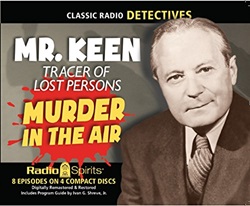
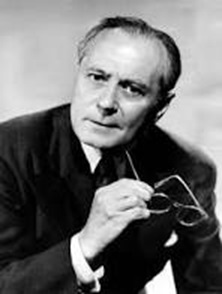 Mr. Keen, Tracer of Lost Persons (1937-1955) aired “The Telephone Book Murder Case” on January 26, 1950 as the 1,275th of its 1,690 episodes. It was the brainchild of, and produced by the team of Frank and Anne Hummert, who were inspired by the 1906 novel The Tracer of Lost Persons by American author and artist Robert W. Chambers.
Mr. Keen, Tracer of Lost Persons (1937-1955) aired “The Telephone Book Murder Case” on January 26, 1950 as the 1,275th of its 1,690 episodes. It was the brainchild of, and produced by the team of Frank and Anne Hummert, who were inspired by the 1906 novel The Tracer of Lost Persons by American author and artist Robert W. Chambers.
Mr. Keen, Tracer of Lost Persons holds the distinction of being the longest running of any detective show on radio, with its 1,690 broadcasts far outstripping its fellow detective shows, including (according to wikipedia): “Nick Carter, Master Detective (726 broadcasts), The Adventures of Sherlock Holmes (657) and The Adventures of the Falcon (473).” Unfortunately, out of the almost 1,700 episodes over its 18-year run, fewer than 60 shows have survived.
Bennett Kilpack (1883-1962, photo top right) starred as Mr. Keen, who came to be known as “the kindly old investigator,” and Jim Kelly would play the role of Keen’s Irish partner Mike Clancy. From 1937-1942 the NBC network aired the show three times a week in short 15-minute episodes, and true to the show’s name involved Mr. Keen tracking down people who had disappeared for one reason or another and had left families, homes, or jobs behind. In November of 1943 (and now with the CBS radio network since 1942) the format changed to full half hour shows, and Mr. Keen’s skills were expanded to include those of a full-fledged investigator, one who used his intellect and cunning not only to find missing persons, but to bring murderers to justice as well. Kilpack played Keen for nearly 1,300 episodes for 13 years, at which time he made his final appearance on October 26, 1950. Following his “retirement” from the show (its 1,314th broadcast), Mr. Keen would be played by Arthur Hughes and Phil Clarke, with the program’s final episode airing on April 19, 1955. While the show absorbed and survived criticism in some quarters for being written to a very broad-based (i.e., lowest common denominator) audience, it enthralled such a large swath of the listening public on a regular basis, providing it with much needed relief from the day to day grind, that it lasted for nearly 20 years, even unto the dawn of the television age.
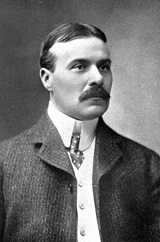
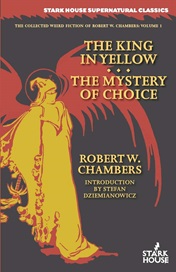 Before teasing this week’s episode, I’d like to give a nod to the author of the book who gave inspiration to the Hummett’s for Mr. Keen, Tracer of Lost Persons. Robert W. Chambers (1865-1933) was a prolific author who wrote dozens of novels, short stories, more than a handful of children’s books, and whose stories of his own work were collected in several volumes, with a number of his detective and/or supernatural tales reprinted in numerous anthologies. Chambers’ most famous work for fans of the fantasy genre is perhaps his 1895 collection of 9 stories, The King in Yellow. His wikipedia page provides the following paragraph of this singular work: “The book contains nine short stories and a sequence of poems; while the first stories belong to the genres of supernatural horror and weird fiction, The King in Yellow progressively transitions towards a more light-hearted tone, ending with romantic stories devoid of horror or supernatural elements. The horror stories are highly esteemed, and it has been described by critics such as E. F. Bleiler and T. E. D. Klein as a classic in the field of the supernatural. Lin Carter called it ‘an absolute masterpiece, probably the single greatest book of weird fantasy written in this country between the death of Poe and the rise of Lovecraft,’ and it was an influence on Lovecraft himself.”
Before teasing this week’s episode, I’d like to give a nod to the author of the book who gave inspiration to the Hummett’s for Mr. Keen, Tracer of Lost Persons. Robert W. Chambers (1865-1933) was a prolific author who wrote dozens of novels, short stories, more than a handful of children’s books, and whose stories of his own work were collected in several volumes, with a number of his detective and/or supernatural tales reprinted in numerous anthologies. Chambers’ most famous work for fans of the fantasy genre is perhaps his 1895 collection of 9 stories, The King in Yellow. His wikipedia page provides the following paragraph of this singular work: “The book contains nine short stories and a sequence of poems; while the first stories belong to the genres of supernatural horror and weird fiction, The King in Yellow progressively transitions towards a more light-hearted tone, ending with romantic stories devoid of horror or supernatural elements. The horror stories are highly esteemed, and it has been described by critics such as E. F. Bleiler and T. E. D. Klein as a classic in the field of the supernatural. Lin Carter called it ‘an absolute masterpiece, probably the single greatest book of weird fantasy written in this country between the death of Poe and the rise of Lovecraft,’ and it was an influence on Lovecraft himself.”
This episode finds Mr. Keen tasked with solving the murder of a rich gentleman. In his relatively low-key manner he sorts through the motley assortment of prospects, some more obvious than others of course, and tries to piece together what few clues and motives present themselves—a few coming to light only after thorough investigation. The crucial bit of evidence fitting the pieces of the mystery, and the identity of the murderer together, is discovered in the oddest and most unlikely of places, within the pages of an old, out of date telephone book. To learn what secrets the book holds and therefore who the murderer is, you’ll have to listen to this carefully constructed half hour drama. What makes even a more traditional murder mystery like this one interesting and a challenge for the reader or listener, is how the author doles out the details, the information, and the cleverness with which he or she plays with listener expectations. “The Telephone Book Murder Case” is no exception.
(The linked CD above contains this episode and 7 others.)
Play Time: 29:37
{This episode of Mr. Keen, Tracer of Lost Persons aired early on a Thursday evening in late January of 1950, which meant the neighborhood gang would be up listening, each in their own warm houses up and down the block, and planning their visit to the nearby newsstand immediately after school the next day, a Friday no less. Black Mask (1920-51) holds the reputation of being the undisputed best of any and all detective pulps, so when a new issue hit the newsstand shelves it was purchased without question. It was a bi-monthly in 1950. Dime Detective (1931-53) was one of the most stable of the detective pulps, providing solid detective fiction for 274 issues over its 18-year lifespan, making it one of the longest running detective magazines of them all. It was a monthly in 1950, though its final three years saw it scale back to a bi-monthly schedule. Thrilling Detective (1931-53) also enjoyed a long publishing history, with 214 issues in its 18-year existence. For its first fourteen or so years it was a monthly but 1946 saw it switch to a bi-monthly, a schedule it would maintain until its final two years when it saw but 9 issues in 1952-53.}
[Left: Black Mask, 1/50 – Center: Dime Detective, 1/50 – Right: Thrilling Detective, 2/50]
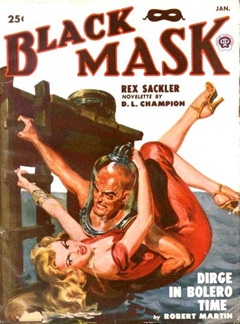
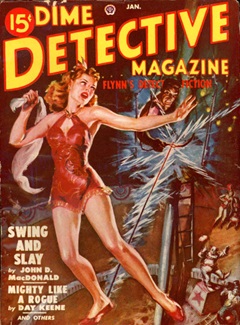
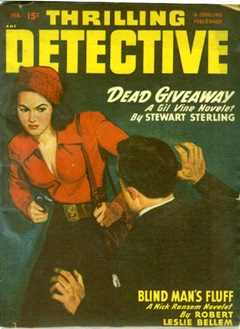
To view the entire list of weekly Old Time Radio episodes at Tangent Online, click here.